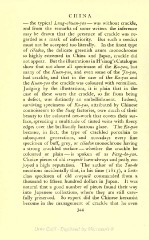Page 422 - Oriental Series Japan and China, Brinkly
P. 422
CHINA
the typical Lung-chuan-yao was without crackle,
and from the remarks of some writers the inference
may be drawn that the presence of crackle was re-
garded as a mark of inferiority. But such a verdict
must not be accepted too literally. In the finest type
of celadon, the delicate greenish azure monochrome
so highly esteemed in China and Japan, crackle did
not appear. But the illustrations in H'siang's Catalogue
show that not alone all specimans of the Ko-yao, but
many of the Kuan-yao, and even some of the yu-yao,
had crackle, and that in the case of the Ko-yao and
the Kuan-yao the crackle was coloured with vermilion.
Judging by the illustrations, it is plain that in the
case of these wares the crackle, so far from being
a defect, was distinctly an embellishment. Indeed,
surviving specimens of Ko-yao, attributed by Chinese
connoisseurs to the Sung factories, owe much of their
beauty to the coloured net-work that covers their sur-
face, spreading a multitude of tinted veins with fleecy
edges over the brilliantly lustrous glaze. The Ko-yao
became, in fact, the type of crackled porcelain to
subsequent generations, and nowadays every fine
specimen of buff, grey, or celadon monochrone having
a strong crackled surface whether the crackle be
coloured or plain is spoken of as Fang-ko-yao.
Choice pieces of old craquele have always and justly en-
joyed a high reputation. The author of the Tao-lu
mentions incidentally that, in his time (1815), a first-
class specimen of old craquele commanded from a
thousand to fifteen hundred dollars in Japan. It was
natural that a good number of pieces found their way
into Japanese collections, where they are still care-
fully preserved. So expert did the Chinese keramist
become in the management of crackle that he even
344

